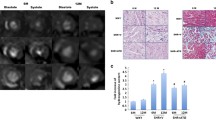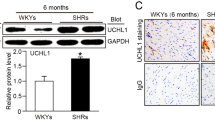Abstract
Previous clinical and experimental studies have demonstrated that statins, the inhibitors of 3-hydroxy-3-methylglutaryl-coenzyme A reductase, can improve left ventricular function in damaged hearts. Also, the normal expression of Ca2+ regulatory proteins is critical for efficient myocardial function. However, it is still unclear whether the beneficial effect of statins on cardiac function is associated with alterations of Ca2+ regulatory proteins. In this study, we investigated the effect of atorvastatin on cardiac function in spontaneously hypertensive rats (SHRs), focusing in particular on its impact on the expression of sarcoplasmic reticulum Ca2+-adenosine triphosphatase (SERCA2a), phospholamban (PLB) and its phosphorylated form (phosphorylated PLB), all of which are Ca2+ regulatory proteins in myocardium. SHRs showed decreases in gene expression of SERCA2a and phosphorylated PLB, and reduction in SERCA activity in the left ventricular myocardium, as well as reduced cardiac function, compared to age-matched Wistar Kyoto rats (WKYs). Furthermore, we showed that in SHRs atorvastatin preserved cardiac dysfunction accompanied by positive alterations in calcium regulatory proteins, with up-regulation in expression of SERCA2a and phosphorylated PLB, and with improvement of SERCA activity. Thus, atorvastatin has positive effects on calcium regulatory proteins, which may be one of the mechanisms of the beneficial effect of statins on cardiac function in spontaneously hypertensive rats.





Similar content being viewed by others
References
Arai M, Alpert NR, MacLennan DH, Barton P, Periasamy M (1993) Alterations in sarcoplasmic reticulum gene expression in human failure: a possible mechanism for alterations in systolic and diastolic properties of the failing myocardium. Circ Res 72:463–469
Bauersachs J, Hiss K, Fraccarollo D, Laufs U, Ruetten H (2006) Simvastatin improves left ventricular function after myocardial infarction in hypercholesterolemic rabbits by anti-inflammatory effects. Cardiovasc Res 72:438–446
Black AE, Sinz MW, Hayes RN, Woolf TF (1998) Metabolism and excretion studies in mouse after single and multiple oral doses of the 3-hydroxy-3-methylgutaryl-coa reductase inhibitor atorvastatin. Drug Metab Dispos 26:755–763
Boknik P, Heinroth-Hoffmann I, Kirchhefer U, Knapp J, Linck B, Luss H, Muller T, Schmitz W, Brodde O, Neumann J (2001) Enhanced protein phosphorylation in hypertensive hypertrophy. Cardiovasc Res 51:717–728
Braz JC, Gregory K, Pathak A, Zhao W, Sahin B, Klevitsky R, Kimball TF, Lorenz JN, Nairn AC, Liggett SB, Bodi I, Wang S, Schwartz A, Lakatta EG, DePaoli-Roach AA, Robbins J, Hewett TE, Bibb JA, Westfall MV, Kranias EG, Molkentin JD (2004) PKC-α regulates cardiac contractility and propensity toward heart failure. Nat Med 10:248–254
Carr AN, Schmidt AG, Suzuki Y, del Monte F, Sato Y, Lanner C, Breeden K, Jing SL, Allen PB, Greengard P, Yatani A, Hoit BD, Grupp IL, Hajjar RJ, DePaoli-Roach AA, Kranias EG (2002) Type 1 phosphatase, a negative regulator of cardiac function. Moll Cell Biol 22:4124–4135
Collins HL, Loka AM, Dicarlo SE (2004) Daily exercise-induced cardioprotection is associated with changes in calcium regulatory proteins in hypertensive rats. Am J Physiol Heart Circ Physiol 288:532–540
Del Monte F, Williams E, Lebeche D, Schmidt U, Rosenzweig A, Gwathmey JK, Lewandowski ED, Hajjar RJ (2001) Improvement in survival and cardiac metabolism after gene transfer of sarcoplasmic reticulum Ca(2+)-ATPase in a rat model of heart failure. Circulation 104:1424–1429
Gupta RC, Mishra S, Rastogi S, Imai M, Habib O, Sabbah HN (2003) Cardiac SR-coupled PP1 activity and expression are increased and inhibitor 1 protein expression is decreased in failing hearts. Am J Physiol Heart Circ Physiol 285:H2373–H2381
Haghighi K, Gregory KN, Kranias EG (2004) Sarcoplasmic reticulum Ca-ATPase-phospholamban interactions and dilated cardiomyopathy. Biochem Biophys Res Commun 322:1214–1222
Harris MB, Blackstone MA, Sood SG, Li C, Goolsby JM, Venema VJ, Kemp BE, Venema RC (2004) Acute activation and phosphorylation of endothelial nitric oxide synthase by HMG-CoA reductase inhibitors. Am J Physiol Heart Circ Physiol 287:H560–H566
Hasenfuss G, Pieske B (2002) Calcium cycling in congestive heart failure. J Mol Cell Cardiol 34:951–969
Hayashidani S, Tsutsui H, Shiomi T, Suematsu N, Kinugawa S, Ide T, Wen J, Takeshita A (2002) Fluvastatin, a 3-Hydroxy-3-Methylglutaryl coenzyme A reductase inhibitor, attenuate left ventricular remodeling and failure after experimental myocardial infarction. Circulation 105:868–873
Jones LR, Besch HR, Fleming JW, McConnaughey MM, Watanabe AM (1979) Separation of vesicles of cardiac sarcolemma from vesicles of cardiac sarcoplasmic reticulum. Comparative biochemical analysis of component activities. J Biol Chem 254:530–539
Kokubo M, Uemura A, Matsubara T, Murohara T (2005) Noninvasive evaluation of the time course of change in cardiac function in spontaneously hypertensive rats by echocardiography. Hypertens Res 28:601–609
Kubo H, Margulies KB, Piacentino V, Gaughan JP, Houser SR (2001) Patients with end-stage congestive heart failure treated with β-adrenergic receptor antagonists have improved ventricular myocyte calcium regulatory protein abundance. Circulation 104:1012–1018
Kubota Y, Umegaki K, Kagota S, Tanaka N, Nakamura K, Kunitomo M, Shinozuka K (2006) Evaluation of blood pressure measured by tail-cuff methods (without heating) in spontaneously hypertensive rats. Biol Pharm Bull 29:1756–1758
Lamberts RR, Vaessen RJ, Westerhof N, Stienen GJ (2007) Right ventricular hypertrophy causes impairment of left ventricular diastolic function in the rat. Basic Res Cardiol 102(1):19–27
Landmesser U, Engberding N, Bahlmann FH, Schaefer A, Wiencke A, Heineke A, Spiekermann S, Hilfiker-Kleiner D, Templin C, Kotlarz D, Mueller M, Fuchs M, Hornig B, Haller H, Drexler H (2004) Statin-induced improvement of endothelial progenitor cell mobilization, myocardial neovascularization, left ventricular function, and survival after experimental myocardial infarction requires endothelial nitric oxide synthase. Circulation 110:1933–1939
Maack C, O’Rourke B (2007) Excitation-contraction coupling and mitochondrial energetics. Basic Res Cardiol 102(5):369–392
Maier LS, Wahl-Schott C, Horn W, Weichert S, Pagel C, Wagner S, Dybkova N, Müller OJ, Nabauer M, Franz WM, Pieske B (2005) Increased SR Ca2+ cycling contributes to improved contractile performance in SERCA2a-overexpressing transgenic rats. Cardiovasc Res 67:636–646
Meyer M, Schillinger W, Pieske B, Holubarsch C, Heilmann C, Posival H, Kuwajima G, Mikoshiba K, Just H, Hasenfuss G (1995) Alterations of sarcoplasmic reticulum proteins in failing human dilated cardiomyopathy. Circulation 92:778–784
Minamisawa S, Hoshijima M, Chu G, Ward CA, Frank K, Gu Y, Martone ME, Wang Y, Ross J Jr, Kranias EG, Giles WR, Chien KR (1999). Chronic phospholamban-sarcoplasmic reticulum calcium ATPase interaction is the critical calcium cycling defect in dilated cardiomyopathy. Cell 99:313–322
Mousa SA, Goncharuk O, Miller D (2007) Recent advances of TNF-alpha antagonists in rheumatoid arthritis and chronic heart failure. Expert Opin Biol Ther 7:617–625
Nef HM, Mollmann H, Skwara W, Bolck B, Schwinger RH, Hamm Ch, Kostin S, Schaper J, Elsasser A (2006) Reduced sarcoplasmic reticulum Ca2+-ATPase activity and dephosphorylated phospholamban contribute to contractile dysfunction in human hibernating myocardium. Mol Cell Biochem 282:53–63
Node K, Fujita M, Kitakaze M, Hori M, Liao JK (2003) Short-term statin therapy improves cardiac function and symptoms in patients with idiopathic dilated cardiomyopathy. Circulation 108:839–843
Porter MJ, Heidkamp MC, Scully BT, Patel N, Martin JL, Samarel AM (2003) Isoenzyme-selective regulation of SERCA2 gene expression by protein kinase C in neonatal rat ventricular myocytes. Am J Physiol Cell Physiol 285:C39–C47
Rejane P, Christophe B, Olicier B et al (2006) Acute antiinflammatory properties of statins involve peroxisome proliferator-activated receptor-α via inhibition of the protein kinase C signaling pathway. Circ Res 98:361–369
Renna BF, Kubo H, MacDonnell SM, Crabbe DL, Reger PO, Houser SR, Libonati JR (2006) Enhanced acidotic myocardial Ca2+ responsiveness with training in hypertension. Med Sci Sport Exer 38:847–855
Sande JB, Sjaastad I, Hoen IB, Bøkenes J, Tønnessen T, Holt E, Lunde PK, Christensen G (2002) Reduced level of serine (16) phosphorylated phospholamban in the failing rat myocardium: a major contributor to reduced SERCA2 activity. Cardiovasc Res 53:382–391
Sevilla MA, Voces F, Carrón R, Guerrero EI, Ardanaz N, San Román L, Arévalo MA, Montero MJ (2004) Amlodipine decreases fibrosis and cardiac hypertrophy in spontaneously hypertensive rats: persistent effects after withdrawal. Life Sci 75:881–891
Simko F, Matuskova J, Luptak I, Krajcirovicova K, Kucharska J, Gvozdjakova A, Babal P, Pechanova O (2004) Effect of simvastatin on remodeling of the left ventricle and aorta in L-NAME-induced hypertension. Life Sci 74:1211–1214
Sola S, Mir MQ, Lerakis S, Tandon N, Khan BV (2006) Atorvastatin improves left ventricular systolic function and serum markers of inflammation in nonischemic heart failure. J Am Coll Cardiol 47:332–337
Sun YL, Hu SJ, Wang LH, Hu Y, Zhou JY (2005) Effect of β-blockers on cardiac function and calcium handling protein in postinfarction heart failure rats. Chest 128:1812–1821
Tanaka K, Honda M, Takabatake T (2004) Anti-apoptotic effect of atorvastatin, a 3-hydroxy-3-methylglutaryl coenzyme a reductase inhibitor, on cardiac myocytes through protein kinase C activation. Clin Exp Pharmacol Physiol 31:360–364
Weber T, Neumann J, Meissner A, Grosse Hartlage M, Van Aken H, Schmitz W, Boknik P (2006) Reduced serine-16 and threonine-17 phospholamban phosphorylation in stunning of conscious dogs: no evidenced for any involvement of protein kinase A or protein phosphatases. Basic Res Cardiol 101:253–260
Wojnicz R, Wilczek K, Nowalany-Kozielska E, Szygula-Jurkiewicz B, Nowak J, Poloński L, Dyrbus K, Badziński A, Mercik G, Zembala M, Wodniecki J, Rozek MM (2006) Usefulness of atorvastatin in patients with heart failure due to inflammatory dilated cardiomyopathy and elevated cholesterol levels. Am J Cardiol 97:899–904
Yasunari K, Maeda K, Minami M, Yoshikawa J (2001) HMG-CoA reductase inhibitors prevent migration of human coronary smooth muscle cells through suppression of increase in oxidative stress. Arterioscler Thromb Vasc Biol 21:937–942
Yoshida J, Yamamoto K, Mano T, Sakata Y, Nishikawa N, Nishio M, Ohtani T, Miwa T, Hori M, Masuyama T (2004) AT1 receptor blocker added to ACE inhibitor provides benefits at advanced stage of hypertensive diastolic heart failure. Hypertension 43:686–691
Zheng X, Hu SJ (2005) Effects of simvastatin on cardiac performance and expression of sarcoplasmic reticular calcium regulatory proteins in rat heart. Acta Pharmacol Sin 26:696–704
Acknowledgments
We express our sincere gratitude to Dr. Iain C. Bruce for revising this manuscript. This research was supported by the National Natural Science Foundation of China (Grant No. 30470715), the Research Fund for the Doctoral Program of Higher Education of China (No. 20040335118), and the Research Fund of the Health Agency of Zhejiang Province (No. 2007A078), and was supported in part by the E-Institute of Shanghai Municipal Education Commission of China (No. E-04010).
Author information
Authors and Affiliations
Corresponding author
Additional information
Returned for 1. Revision: 7 January 2008 1. Revision received: 25 July 2008
Returned for 2. Revision: 11 August 2008 2. Revision received: 8 September 2008
Rights and permissions
About this article
Cite this article
Yao, L., Chen, GP., Lu, X. et al. Effects of atorvastatin on calcium-regulating proteins: a possible mechanism to repair cardiac dysfunction in spontaneously hypertensive rats. Basic Res Cardiol 104, 258–268 (2009). https://doi.org/10.1007/s00395-008-0751-y
Received:
Accepted:
Published:
Issue Date:
DOI: https://doi.org/10.1007/s00395-008-0751-y




